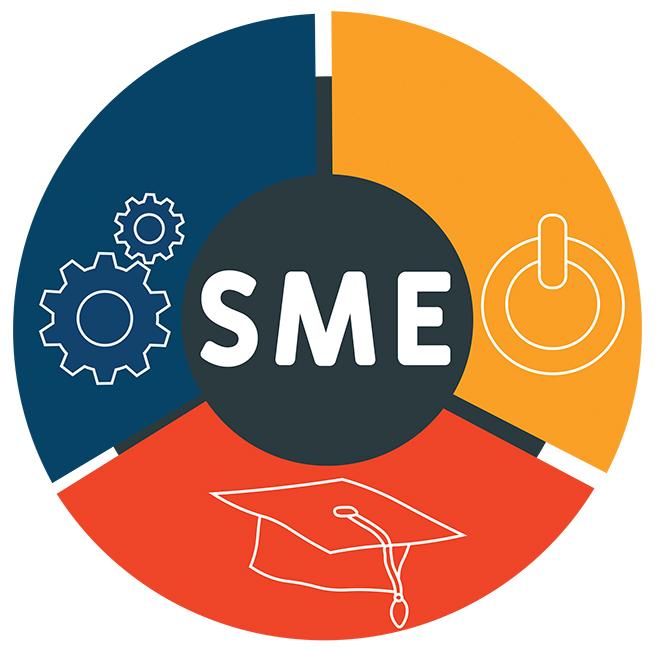Maximizing SME Partnerships: Simple Strategies for L&D Leaders

Subject Matter Experts (SMEs) are a key resource that can make or break a training initiative. SMEs provide the expertise that forms the foundation of any training program, but working with them effectively requires a strategic approach to ensure that training meets the learners’ needs, aligns with business objectives, and stays within budget and time restrictions.
Preparing to Engage Your SMEs
Subject Matter Experts possess a wealth of knowledge and experience, and it’s our job as instructional designers to organize that knowledge in a way that’s meaningful for learners. It’s easy for SMEs to share everything they know about a topic, but that overabundance of information can quickly overwhelm new learners. That’s why it’s crucial to have a learner profile and clear learning objectives prepared before engaging in conversations with SMEs.
Sometimes, SMEs may be overbooked or only available for limited interactions. Situations like these require us to thoroughly prepare before every meeting, making sure that we have the right prompts and questions ready to extract the specific information we need to create the right training for the learners.
By preparing to ask targeted questions, we can focus on the learner’s needs and steer the conversation with SMEs toward what will truly be useful. Just like with AI, the quality of the questions we ask directly impacts the quality of the content we receive. When we prepare questions that focus on the learner’s motivations, pain points, and learning goals, we ensure that the SME’s expert-level knowledge is translated into practical, digestible content.
Overcoming Common L&D Challenges
The instructional designer faces every challenge with the goal of creating meaningful, effective training that delivers business results, engages learners, and works within budget and time limitations. Based on our experience at d’Vinci Interactive, here are four strategies that have proven to be successful .
Strategy 1: Tailor Training to Business Needs
One of the most important ways to maximize your partnership with SMEs is to ensure that the training you develop directly aligns with your organization’s business goals. This focus helps ensure that the training delivers measurable results and gains the support of business leaders.
Imagine a company experiencing production delays and seeking a training solution to address this issue. Through focused conversations with SMEs, L&D teams can identify the most critical bottlenecks in the process. Rather than covering every aspect of production, the training would zero in on key areas that directly impact productivity. This targeted approach allows for a more effective solution, addressing the business's specific needs and leading to noticeable improvements in performance and efficiency.
Takeaway: Align training with business goals by identifying specific pain points or objectives early in your conversations with SMEs.
Strategy 2: Leverage Cost-Effective Learning Solutions
Budget is always a concern, especially when it comes to training. However, it’s possible to create effective training solutions without breaking the bank by leveraging cost-effective development tools and approaches.
For one client, we used rapid development tools to create a series of bite-sized eLearning modules. These modules were not only cost-effective to produce but also flexible and easy to update as the client’s needs evolved. By focusing on delivering just-in-time learning in small, digestible chunks, we were able to provide a high-impact learning experience that met their goals without exceeding the budget.
Takeaway: Use rapid development tools and modular design approaches to create cost-effective learning solutions that can adapt to your organization’s changing needs.
Strategy 3: Implement Flexible Learning Models
Time constraints are a reality for both L&D teams and SMEs. Often, SMEs are pulled in many different directions, making it difficult for them to dedicate time to training development. Similarly, learners may struggle to find the time to engage with lengthy, in-depth training programs.
One solution to this challenge is to implement flexible learning models, such as microlearning. For example, we worked with a client to develop a series of microlearning courses that provided essential knowledge to a nationwide audience. This approach allowed the SMEs to contribute content in smaller increments, which fit better with their schedule. It also made the training more meaningful to learners, who could customize their educational experience by focusing on areas where they have knowledge and experience gaps.
Takeaway: Use microlearning or other flexible learning models to accommodate time constraints and increase engagement for both SMEs and learners.
Strategy 4: Use Technology to Scale Training Efficiently
Technology can be a powerful tool for scaling training initiatives, particularly when your organization has a distributed workforce or remote employees. By leveraging eLearning platforms and mobile-responsive design, you can ensure that training is accessible to all employees, no matter where they are.
In one instance, we worked with a client who needed a way to manage both in-person and virtual training for thousands of learners across their state. We helped them implement a custom Learning Management System (LMS) that allowed them to track and manage training experiences for a wide range of users—from students to faculty and administrators. This scalable solution helped streamline both virtual and classroom-based learning, ensuring that everyone had access to consistent, high-quality training no matter where they were located.
Takeaway: Implement a customized LMS to manage large-scale training programs efficiently, whether in-person or online.
Best Practices for Partnering with SMEs
Working with SMEs is all about collaboration, and it’s important to remember that while SMEs are experts in their field, learners are not. That’s why our team uses a simple framework to guide conversations with SMEs and ensure the training stays learner-centered:
- What are your key business goals and challenges? This helps frame the training around solving real business problems.
- What are the underlying causes of these challenges? Identifying root causes will help determine if the issue is knowledge, skills, or motivation.
- What measurable outcomes do you want from this training? Clarifying desired results ensures the training impacts behavior and performance.
- Who is the target audience? Knowing the learners' backgrounds, knowledge levels, and motivations helps tailor the content.
- What metrics will define success? Setting KPIs and success metrics will guide the training design and evaluation.
- By answering these questions, we can create a strong foundation for the training content, while also leaving room for creativity in delivery a personalized connection with the learners.
Practical Takeaways for L&D Leaders
- Collaborate with SMEs to align training with immediate business goals
- Use cost-effective rapid development tools to create high-quality, scalable training
- Implement flexible learning models like microlearning to meet time constraints and boost engagement
- Leverage technology to scale your training and ensure accessibility across locations and devices
At d'Vinci Interactive, we’ve seen the positive impact of these strategies in our own projects, and we encourage you to experiment with them in your own training initiatives.

By Ashlea Novalis, Instructional Designer, Project Manager
About Us
d'Vinci Interactive is an award-winning comprehensive learning solutions provider for corporate, government, medical, non-profit, and K-12 target markets.
Ready to Connect?
Contact us today to start the conversation. We work with you to find innovative solutions that drive a sense of shared accomplishment and trust.